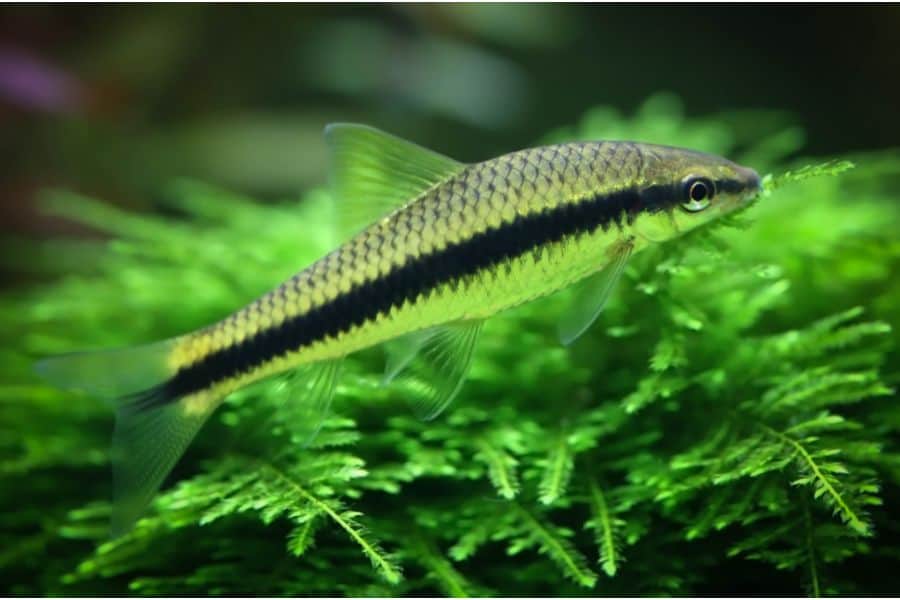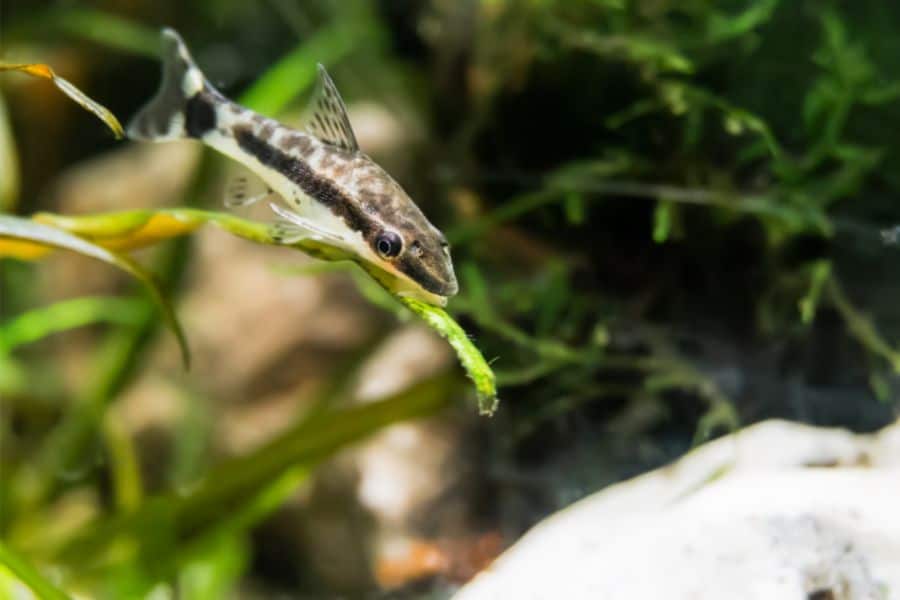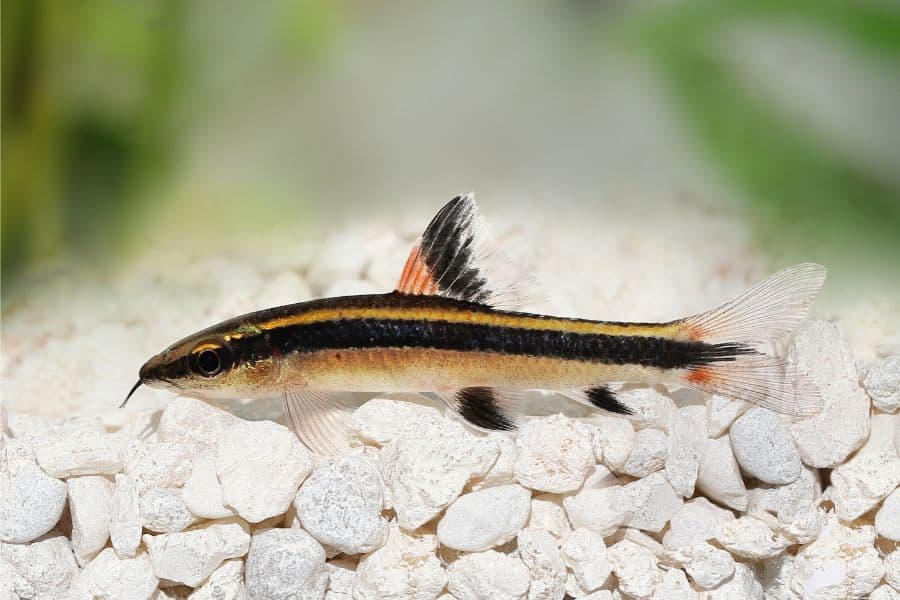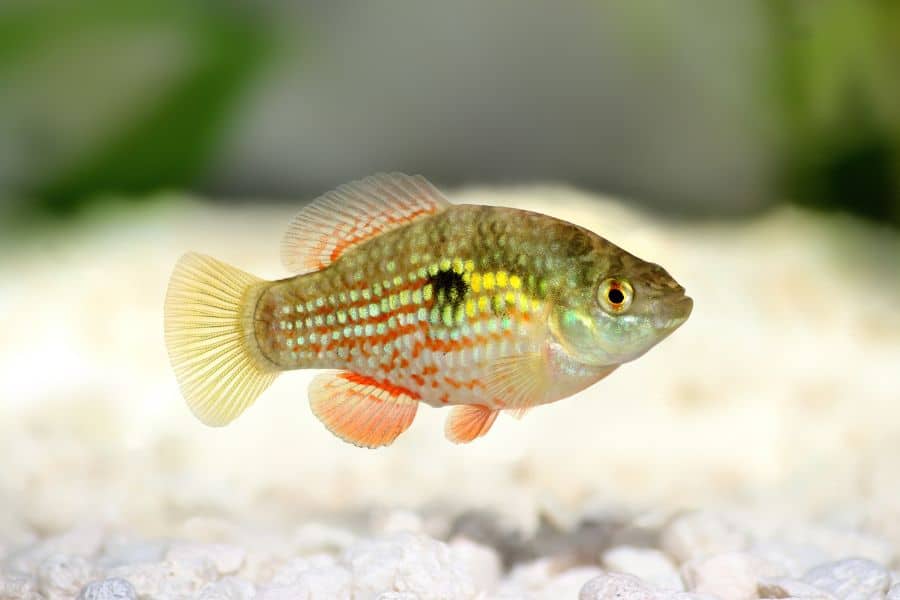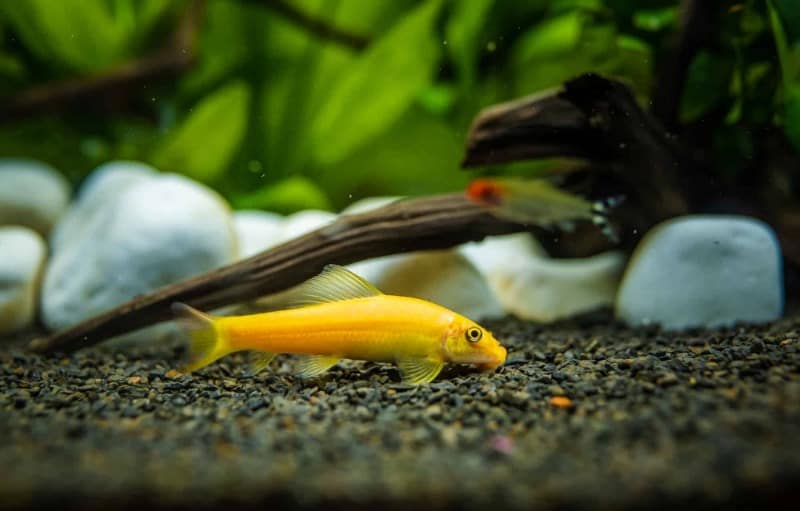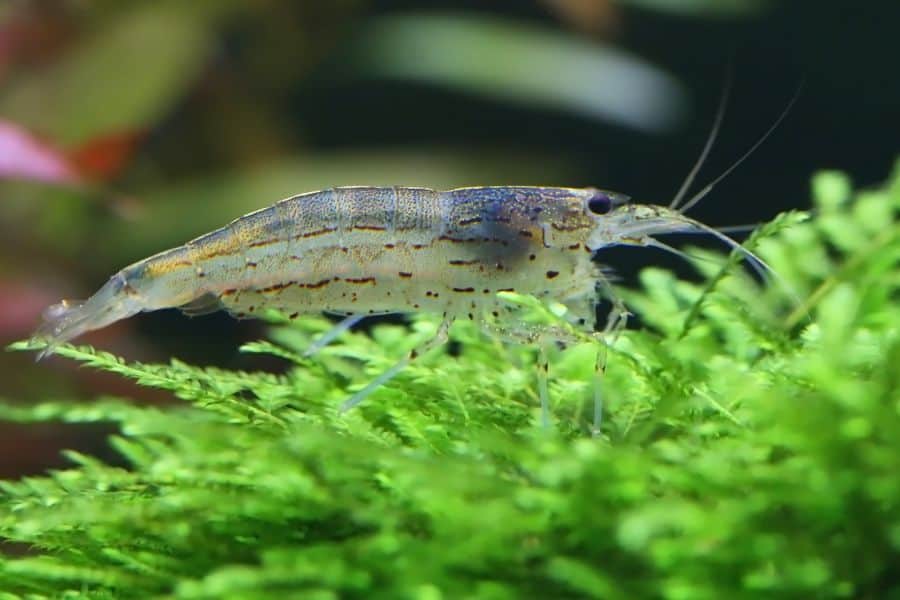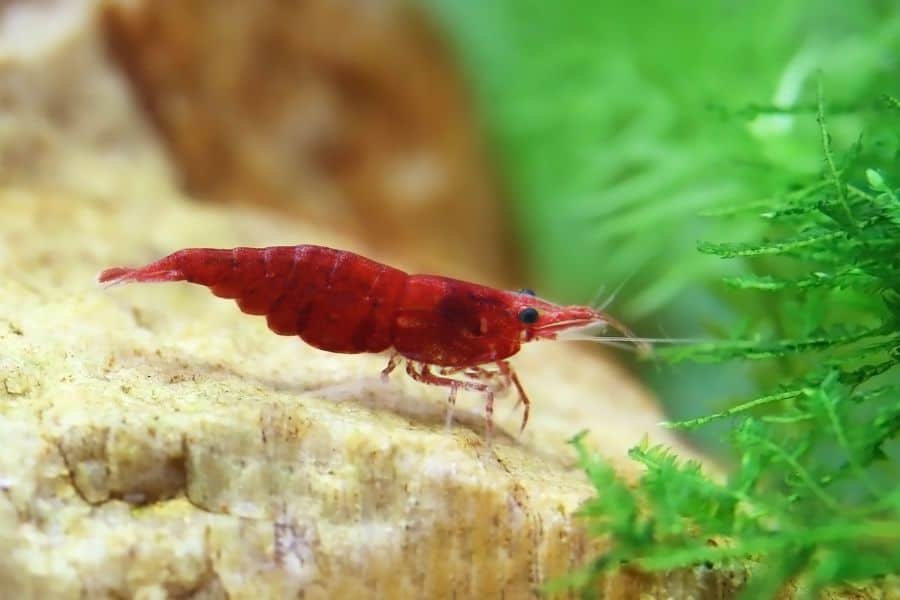Aquariums can accommodate a variety of algae that can ruin the appearance of your setup. Black beard algae can obscure the glass and block filters.
Due to their unsightliness and the problems they make, black beard algae are considered a nuisance in fishkeeping.
That’s why you need to find a way to eradicate them for good and prevent them from getting appearing again. There are a lot of different ways to remove black beard algae.
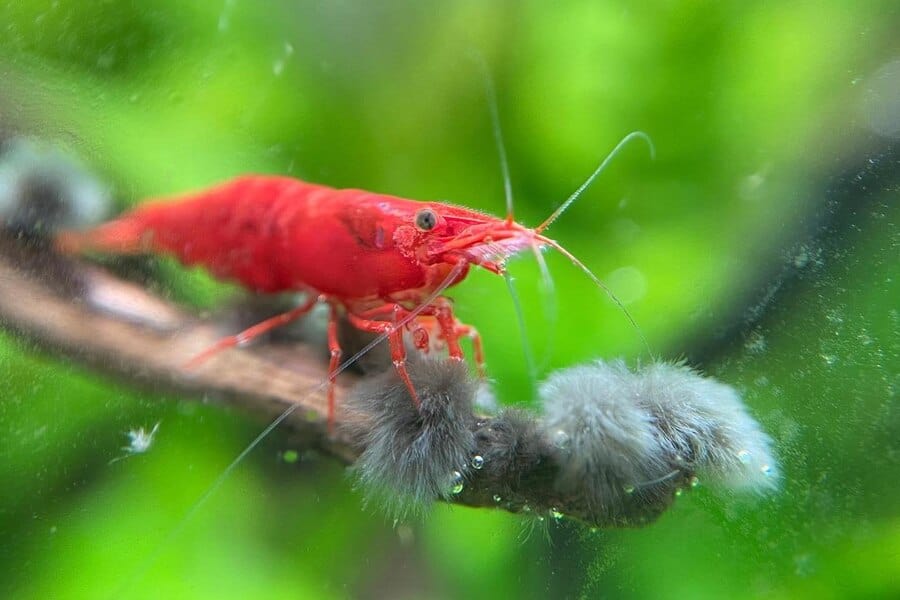
The most effective way is to employ algae eaters and fish that eat black beard algae. For example, you can use Siamese Algae Eater and Flying Fox, just to mention a few.
Keep reading to find out how to treat black beard algae in your fish tank. You will meet different black beard algae eaters and learn more about them.
What Are Black Beard Algae?
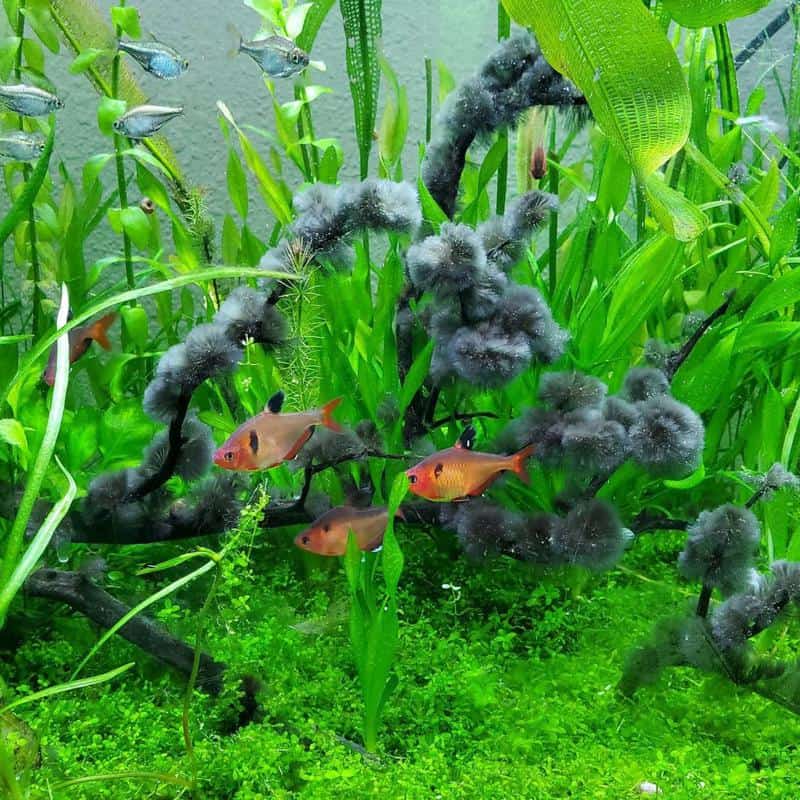
Before moving on to algae eaters, we will first shed some light on black beard algae. What is it?
Also known as brush algae, black beard algae (or shortly BBA) are filamentous species that are a part of the red algae family. As their name suggests, they are black in color. Yet, their natural color may vary from a deep black to grey and dark green.
Black beard algae (Audouinella sp.) has a hairy and long appearance. If left untreated, this fast-growing cyanobacterium can quickly multiply and grow, taking over your tank in just a few days.
Just like other types of algae, it usually grows on aquarium plants, especially on the edges of the leaves. After being attached to the leaves and grass, black beard algae are very hard to shift altogether.
It can also grow on aquarium decorations, equipment, gravel grains, rocks, and driftwood. This simple organism grows in furry tufts, which look like a black brush or beard.
As it turned out, black beard algae thrive in aquariums in which the level of nitrate is high. They generally prefer soft water and high-light environments.
Are they harmful to fish? While black beard algae are quite unsightly, they aren’t harmful at all. What’s more, some fish enjoy consuming them.
Black Beard Algae Causes
If you identify the cause of algae infection, you will be able to take the right preventive measure. This will ensure that algae do not take over your tank.
Here are the four most common causes of brush algae:
- Poor quality of water
- Too many plants in your aquarium
- High nitrate levels
- Too much light
These algae can withstand almost any change in water quality parameters. That makes them daunting to deal with. Luckily, you aren’t hopeless about this issue.
But if you add the best black beard algae eaters to your aquarium, you can solve this problem without much effort. Read on to discover these amazing eaters.
Top 8 Black Beard Algae Eaters
Okay, you are now more familiar with black beard algae. It is time to meet fish and other organisms that eat this kind of algae.
We will take a closer look at fish that are proven to be effective at eliminating black beard algae. Are you ready?
Fish That Eat Black Beard Algae
1. Siamese Algae Eater (SAE)
General Characteristics
Siamese Algae Eater (Latin name: Crossocheilus oblongus) is a freshwater fish with an elongated body and a long, thin, flat head. It is native to Southeast Asia and can grow up to six inches in length.
They are typically brown or greyish with a black stripe along the body on either side. Down their back, they have a white stripe.
The Siamese Algae Eater is one of the most popular freshwater aquarium fish that people keep as pets. That’s because they are easy to care for. Plus, they eat just about any algae that grow in an aquarium. This makes them an excellent choice for keeping your tank clean and healthy.
Algae Eating Capabilities
Siamese algae eater is no doubt the best algae eater out there. This well-known kind of fish is widely suggested for removing brush algae from aquariums.
That’s why it is our first choice on this list. To get the most out of this algae eater, make sure your fish tank is at least 36 inches long and 30 gallons (about 114 liters) large.
SAE is peaceful fish that can be used in any community tank. What makes this fish the most effective algae eater is that it also consumes the nitrates required for algae growth.
When Siamese algae eaters are still young, they are capable of destroying nearly every alga, even those that other fish avoid eating. Still, they gradually stop consuming algae and start to focus on other food sources with age.
That said, look for younger individuals when buying them. Be sure to purchase the appropriate species. There are many fish species that are marketed as Siamese algae eaters. They are another species, though.
2. Otocinclus Catfish
General Characteristics
The Otocinclus Catfish is a small freshwater fish found in the Amazon River in South America. It is also known as “Oto”. The Latin name is Otocinclus sp.
This hardy easy-to-care fish features a gentle disposition and a voracious appetite for algae. It can thrive in both saltwater and freshwater environments.
When buying these cute creatures, remember that they are not very large fish and can only grow to about 4 inches long. This means you can “employ” them in smaller tanks as well.
Algae Eating Capabilities
They are often used to help keep the tank clean by eating algae and other organisms on the tank’s walls. Black beard algae are no exception.
The Otocinclus Catfish can help you get rid of these unsightly algae within a relatively short period of time. It is an excellent choice for beginners looking to clean up black beard algae in an easy yet effective way.
All you need to do is add a couple of these “guys” to your fish tank and wait a bit. After a few days or weeks, depending on the intensity of the algae infection, they will make your tank clean again.
You may wonder: “How do these catfish work?” On their belly, they have small suction cups that allow them to attach their body to different surfaces. Once anchored, they start to eat any algae (including black beard algae) they come across, munching on them nonstop.
Also Read: Aquarium Catfish Types
3. Flying Fox
General Characteristics
Many people confuse the Siamese Algae Eaters (SAE) with flying foxes. So, be careful when buying them.
How do you recognize them? Well, their coloration is a bit more reddish. Flying fox also has a long thin body (up to 6 inches in length) with a relatively large head.
The abdominal area of these little freshwater fish is flat. There is a white hue at the lower half of their body and a gold-yellowish stripe on top of the distinctive dark line.
The female individuals are larger than the male. The male has bright colors on its tail while the females have no color at all on their tail.
Flying fox is a type of fish that live in the streams, lakes, and ponds of Southeast Asia. They are usually found near the surface of the water and feed on plankton, small crustaceans, algae, and other small organisms.
Algae Eating Capabilities
Flying fox fish (Epalzeorhynchos Kalopterus) does pretty well in most community aquariums. Even so, one of the things you should watch out for when buying flying foxes is that they could be somewhat aggressive compared to SAE.
Flying foxes are not as effective as Siamese Algae Eaters at exterminating brush algae. In spite of that, they can still do a great job of preventing and removing them from your tank. They prefer eating hair algae and black beard algae in fish tanks.
Bear in mind that the effectiveness of each individual is different. There’s no way to check it out before making a purchase. The “service” you get from them can be hit-or-miss.
Aside from the algae themselves, flying foxes consume the nitrates too. This way they prevent algae from growing in aquariums. Therefore, it is worth considering flying foxes anyway.
4. Florida Flagfish (American Flag Fish)
General Characteristics
This lovely freshwater fish inhabits Florida, as its name implies. Florida Flagfish can be found in rivers, ponds, streams, and lakes. It’s typically found in shallow waters near shore and inhabits both brackish and freshwater habitats.
It has a long and thin elongated body with a brownish-yellow coloration on its back and white on its belly. This beautiful fish has a tapering head and can reach up to six inches in length.
The species is considered overfished. That’s because it has been extensively harvested for food, bait, and sport fishing.
Algae Eating Capabilities
While not commonly used in fishkeeping, Florida Flagfish can help remove black beard algae. Bear in mind that it is killifish.
This means it requires a lot of care. That is why many people would not buy Florida Flagfish just to remove algae from their fish tanks.
Nevertheless, you should consider adding this demanding fish to your aquarium. It might be a good solution to the black beard algae problem.
5. Chinese Algae Eaters (CAE)
General Characteristics
Chinese algae eater is a small easy-to-care species of fish. This golden-colored fish is just a few inches long and its slender body is usually pale brown with a lighter belly.
There’s a black stripe running along the entire body. The fins are very small. Due to a miniature dorsal fin with a few firm rays, the appearance of this fish is fairly spiky.
Perhaps the most typical characteristic of the CAE is a big mouth with large lips. It enables fish to make a vacuum against the glass and other smooth surfaces.
Algae Eating Capabilities
This kind of fish is frequently utilized for controlling algae in fish tanks. It comes as no surprise, given that Chinese algae eaters consume a broad range of algae. Yes, they eat black beard algae as well.
They are pretty cheap. Be careful before making a choice because it could be a controversial choice.
Some individuals, especially the larger ones, may become aggressive as they’re getting old. Hence, we recommend using younger peaceful individuals to remove brush algae.
TIP: If you have an aquarium full of fish, it’s best to buy only one young Chinese algae eater. Once it solves your problem with black beard algae, return it to the fish shop before it gets too big.
Other Algae Eaters
6. Nerite Snails
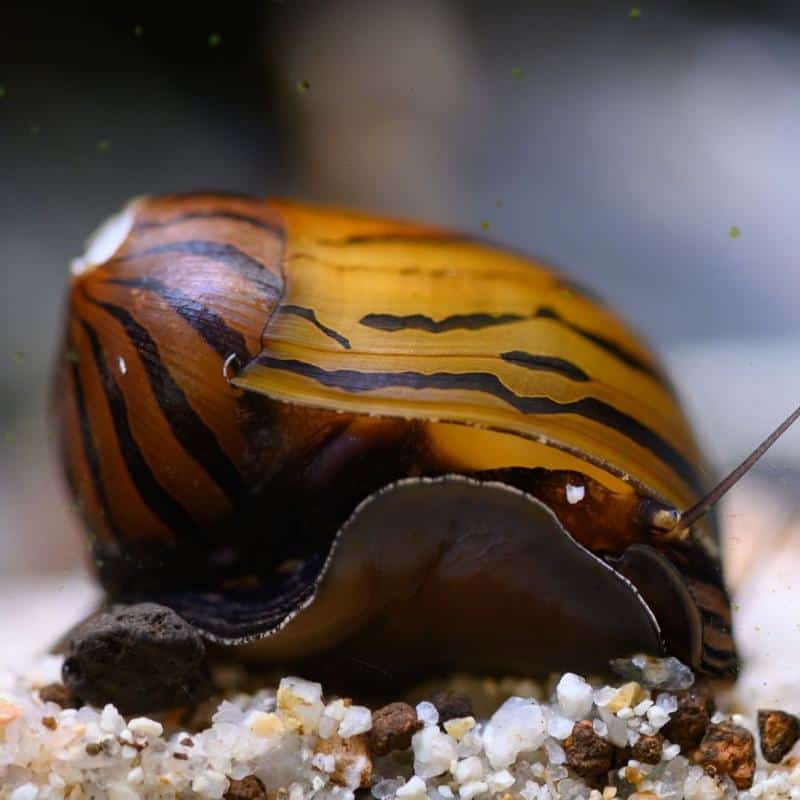
One of the most popular varieties of snails in fishkeeping is the nerite snail. Many fishkeepers add these gorgeous snails to their aquariums even if they don’t deal with an algae problem.
This is because these admirable snails are not capable of reproducing in freshwater aquariums. Plus, they are excellent at controlling different types of algae, including brush algae.
Nerite snails (Vittina natalensis) are often found in rivers and lakes of North America. They are typically green or brown and have shells with various mottles, depending on the type. The most popular types include:
- Black Racer Nerite Snail
- Tiger Nerite Snail
- Zebra Nerite Snail
- Olive Nerite Snail
- Horned Nerite Snail
These efficient algae eaters are a safe and useful addition to any fish tank. Be sure to consider the size and type of your setup before adding them.
If they enjoy the living conditions, these tank cleaners will be driving around your aquarium tirelessly all day long. In addition to algae, they will clean it from leftover fish food and pieces of dead plants.
7. Amano Shrimp
This kind of shrimp can be found in a lot of freshwater aquarium setups around the world. However, they originate from Japan.
What makes them a good choice? First of all, these sweet creatures are highly effective at cleaning up aquariums. Besides black beard algae and other algae types, they also eat leftover fish food and detritus.
You can keep these hardy free-swimming crustaceans in your tank for years. They are not finicky compared to other shrimp types. Remember that they can’t reproduce in freshwater tanks.
If the water parameters meet their needs, they will keep it clean all the time. Add several individuals of Amano shrimp and your algae problem will be decimated quickly. Give them a try!
8. Cherry Shrimp
Last but not least, you should consider Cherry shrimp to get rid of black beard algae. This fast-breeding shrimp is very efficient at eating algae.
It is not picky at all. Cherry shrimps eat different kinds of algae, including black beard algae. You will be surprised at how quickly Cherries do it.
They are able to spend the whole day searching for food. Once they locate algae in your fish tank, they will eat them up straight away.
Depending on the size of your tank, you should introduce a few shrimps or an entire colony. Then sit back and wait. In a short period, they will create a large “algae-eating brigade” by multiplying quickly.
Don’t worry – overcrowding is not a problem because these crustaceans don’t have a high bioload. Black beard algae will have no chance of surviving!
Related:
- How to Treat White Algae in Your Fish Tank?
- 14 Best Algae Eaters
- Brown Hair Algae: How To Manage Them?
Conclusion
Be sure to identify the signs of algae infection on time. If you recognize black beard algae in your aquarium, employ these useful eaters right away to make your fish tank safe again.
Siamese Algae Eaters, Otocinclus Catfish, Chinese Algae Eaters, Florida Flagfish, and Flying Foxes are a safe bet. They are all proven to remove black beard algae efficiently. So, you can’t go wrong with them.
Additionally, you should consider using Nerite Snails and Amano Shrimp as well. They can also do a great job of removing pesky algae from aquariums. Make your aquarium free of harmful algae!
